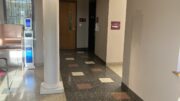Each local school division in Virginia must locate, identify, evaluate, and provide a free appropriate public education to all children with disabilities residing in its district. This on-going effort to locate children with disabilities is required by the Individuals with Disabilities Education Act and Section 504 of the Rehabilitation Act of 1973.
The Wythe County Public School System offers a variety of special education programs, which serve children ages two through twenty-one, inclusive, and provide a FREE APPROPRIATE PUBLIC EDUCATION. Children with disabilities whose second birthday falls on or before September 30 or who have not reached their twenty-second birthday on or before September 30 of the current school year can be considered for these services.
In order to identify and place children with disabilities, the Wythe County School Division follows several procedures. A child may be referred by a teacher, parent, physician, outside agency, staff member, or concerned citizen. To make a referral, the individual need only contact the child’s teacher or building administrator.
Once written parental consent is obtained and parents have been informed of their rights, and given Virginia Special Education Procedural Safeguards Requirements under the Individuals with Disabilities Education Act and Written Notification, the evaluation process begins. This process ensures that each child is assessed by a qualified professional in all areas related to the suspected disability, including, when appropriate, health, vision, hearing, social and emotional status, general intelligence, academic performance, communicative status, and motor abilities. All of this testing is free of charge to parents. When the evaluations are completed, a committee meets to decide if the child qualifies for special education.
A child may qualify for one or more programs depending on the disability.
The 13 Disabilities Defined by the Individuals with Disabilities Education Act (IDEA)
IDEA provides definitions of the 13 disability categories. Federal definitions guide how states define who is eligible for a free appropriate public education under IDEA. The definitions are as follows:
1. Autism…
…means a developmental disability significantly affecting verbal and nonverbal communication and social interaction, generally evident before age three that adversely affects a child’s educational performance.
Other characteristics often associated with autism are engaging in repetitive activities and stereotyped movements, resistance to environmental change or change in daily routines, and unusual responses to sensory experiences. The term autism does not apply if the child’s educational performance is adversely affected primarily because the child has an emotional disturbance, as defined in #4 below.
A child who shows the characteristics of autism after age 3 could be diagnosed as having autism if the criteria above are satisfied.
2. Deaf-blindness…
…means concomitant [simultaneous] hearing and visual impairments, the combination of which causes such severe communication and other developmental and educational needs that they cannot be accommodated in special education programs solely for children with deafness or children with blindness.
3. Deafness…
…means a hearing impairment so severe that a child is impaired in processing linguistic information through hearing, with or without amplification, that adversely affects a child’s educational performance.
4. Emotional Disturbance…
…means a condition exhibiting one or more of the following characteristics over a long period of time and to a marked degree that adversely affects a child’s educational performance:
- An inability to learn that cannot be explained by intellectual, sensory, or health factors.
- An inability to build or maintain satisfactory interpersonal relationships with peers and teachers.
- Inappropriate types of behavior or feelings under normal circumstances.
- A general pervasive mood of unhappiness or depression.
(e) A tendency to develop physical symptoms or fears associated with personal or school problems.
The term includes schizophrenia. The term does not apply to children who are socially maladjusted, unless it is determined that they have an emotional disturbance.
5. Hearing Impairment…
…means an impairment in hearing, whether permanent or fluctuating, that adversely affects a child’s educational performance but is not included under the definition of “deafness.”
6. Intellectual Disability…
…means significantly sub-average general intellectual functioning, existing concurrently [at the same time] with deficits in adaptive behavior and manifested during the developmental period, that adversely affects a child’s educational performance.
7. Multiple Disabilities…
…means concomitant [simultaneous] impairments (such as intellectual disability-blindness, intellectual disability-orthopedic impairment), the combination of which causes such severe educational needs that they cannot be accommodated in special education programs solely for one of the impairments. The term does not include deaf-blindness.
8. Orthopedic Impairment…
…means a severe orthopedic impairment that adversely affects a child’s educational performance. The term includes impairments caused by a congenital anomaly, impairments caused by disease (e.g., poliomyelitis, bone tuberculosis), and impairments from other causes (e.g., cerebral palsy, amputations, and fractures or burns that cause contractures).
9. Other Health Impairment…
…means having limited strength, vitality, or alertness, including a heightened alertness to environmental stimuli, that results in limited alertness with respect to the educational environment, that—
(a) is due to chronic or acute health problems such as asthma, attention deficit disorder or attention deficit hyperactivity disorder, diabetes, epilepsy, a heart condition, hemophilia, lead poisoning, leukemia, nephritis, rheumatic fever, sickle cell anemia, and Tourette syndrome; and
(b) adversely affects a child’s educational performance
10. Specific Learning Disability…
…means a disorder in one or more of the basic psychological processes involved in understanding or in using language, spoken or written, that may manifest itself in the imperfect ability to listen, think, speak, read, write, spell, or to do mathematical calculations. The term includes such conditions as perceptual disabilities, brain injury, minimal brain dysfunction, dyslexia, and developmental aphasia. The term does not include learning problems that are primarily the result of visual, hearing, or motor disabilities; of intellectual disability; of emotional disturbance; or of environmental, cultural, or economic disadvantage.
11. Speech or Language Impairment…
…means a communication disorder such as stuttering, impaired articulation, a language impairment, or a voice impairment that adversely affects a child’s educational performance.
12. Traumatic Brain Injury…
…means an acquired injury to the brain caused by an external physical force, resulting in total or partial functional disability or psychosocial impairment, or both, that adversely affects a child’s educational performance. The term applies to open or closed head injuries resulting in impairments in one or more areas, such as cognition; language; memory; attention; reasoning; abstract thinking; judgment; problem-solving; sensory, perceptual, and motor abilities; psychosocial behavior; physical functions; information processing; and speech.
The term does not apply to brain injuries that are congenital or degenerative, or to brain injuries induced by birth trauma.
13. Visual Impairment Including Blindness…
…means an impairment in vision that, even with correction, adversely affects a child’s educational performance. The term includes both partial sight and blindness.
An Individualized Education Program (IEP) is developed for each student previously identified as eligible to receive special education and related services and functions to provide an appropriate education for that student. The child’s teacher, parent, school administrator, the child, if appropriate, and other individuals, at the discretion of the parents or school division, develop the individual education program for the student. The program is reviewed and updated at least annually. Eligibility for special education programs and services is reviewed at least every three years.
Each school division in the Commonwealth of Virginia is responsible for the identification, evaluation, and placement associated with the provision of a FREE AND APPROPRIATE PUBLIC EDUCATION for all students with disabilities residing within the division. The educational setting for the provision of special education services is the environment determined to be the least restrictive for the individual child.
More information regarding each program or service provided for a student with disabilities may be obtained by writing to the Special Education Department at Wythe County Public Schools, 1570 West Reservoir Street, Wytheville, VA 24382 or by telephoning them at 276-228-5411.






